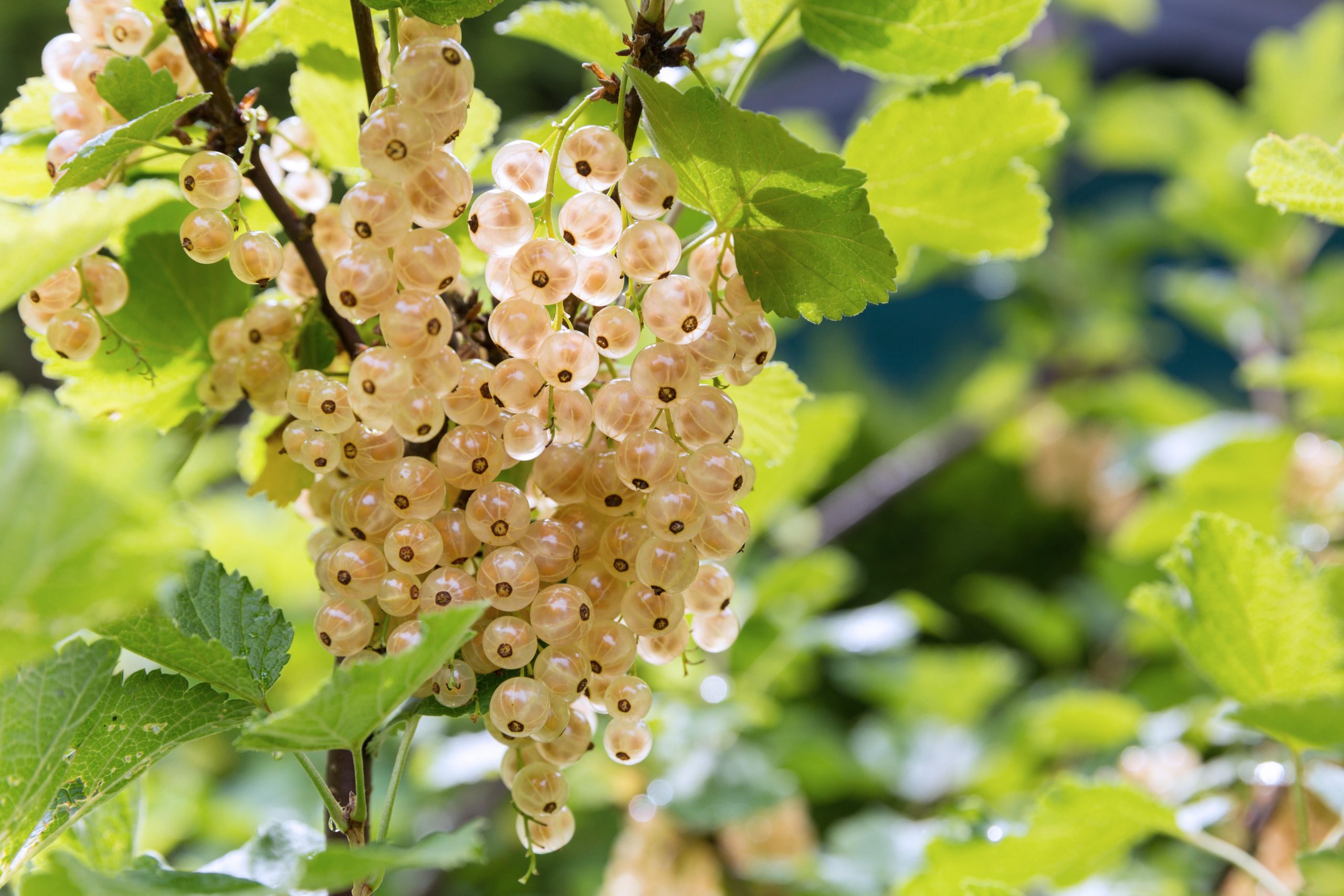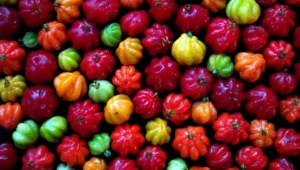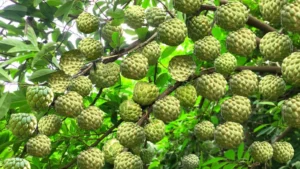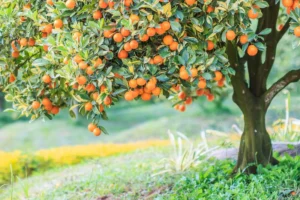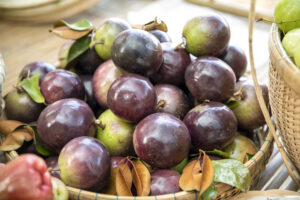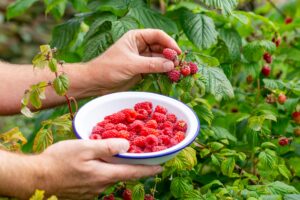How to Grow and Care for White Currants: The Complete Guide
White currants are one of the garden’s hidden treasures—beautiful, productive, and surprisingly easy to grow. Whether you’re looking to add something special to your home garden or expand your edible landscape, these jewel-like berries deserve a spot in your growing space. With their translucent white fruits, sweet-tart flavor, and impressive nutritional profile, white currants (Ribes sativum) offer both ornamental beauty and culinary versatility.
In this comprehensive guide, you’ll learn everything you need to know about growing white currants successfully—whether in your garden, in containers, or from seed. We’ll explore the best varieties for US gardens, proper planting techniques, essential care requirements, and creative ways to use your harvest.
What Are White Currants?
White currants are closely related to red currants—they’re actually a cultivated variety of the same species (Ribes sativum), with a recessive gene that reduces the berry’s pigmentation. While they share many growing requirements with their red cousins, white currants typically offer a sweeter, less acidic flavor that many gardeners find more appealing for fresh eating.
According to the USDA Plant Database, white currants thrive in USDA hardiness zones 3-8, making them suitable for much of the continental United States. These deciduous shrubs typically grow 3-5 feet tall and wide, with a lifespan of 12-15 years when properly maintained.
Benefits of Growing White Currants
Before diving into growing instructions, let’s consider why white currants deserve space in your garden:
- Nutritional powerhouses: Rich in vitamin C, antioxidants, and fiber
- Cold-hardy: Survive winter temperatures as low as -40°F in dormancy
- Low maintenance: Require minimal care once established
- Productive: A mature bush can yield 4-5 pounds of fruit annually
- Versatile in the kitchen: Perfect for jams, jellies, desserts, and beverages
- Attractive landscape plants: Beautiful in garden borders or as specimen plants
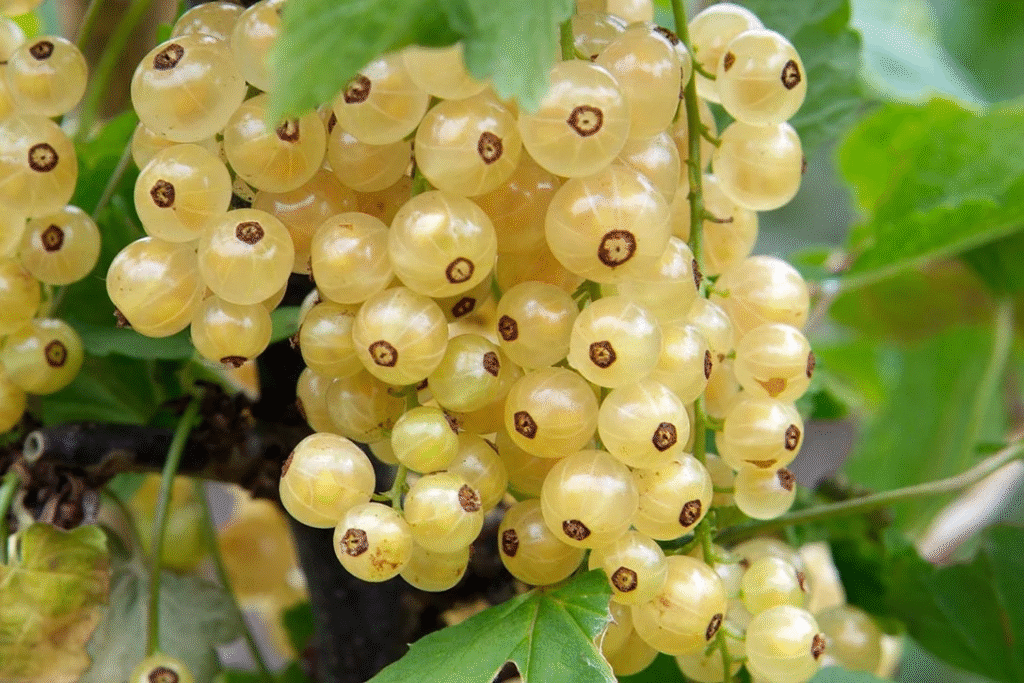
Best White Currant Varieties for US Gardens
When selecting white currant varieties for your garden, consider your climate, available space, and intended use. Here are some top-performing varieties in the US market:
| Variety | Size/Growth Habit | Flavor Profile | Disease Resistance | Best Features |
|---|---|---|---|---|
| ‘White Imperial’ | 3-4 ft tall, compact | Sweet with mild acidity | Moderate powdery mildew resistance | Excellent fresh eating, heavy yields |
| ‘Primus’ | 4-5 ft tall, upright | Sweet-tart, aromatic | Good resistance to anthracnose | Early ripening, good for northern gardens |
| ‘White Grape’ | 3-4 ft tall, spreading | Very sweet, mild | Good mildew resistance | Large berries, excellent for desserts |
| ‘Blanka’ | 4-5 ft tall, vigorous | Sweet with balanced acidity | Excellent disease resistance | High yields, cold hardy to zone 3 |
| ‘Pink Champagne’ | 3-4 ft tall, compact | Sweet with floral notes | Moderate disease resistance | Pale pink berries, ornamental value |
How to Grow White Currants in Your Garden
Selecting the Right Location
White currants are adaptable but do have some specific requirements for optimal growth:
- Light requirements: Part shade to full sun, with afternoon shade in hot regions
- Soil conditions: Well-drained, loamy soil with pH 6.0-6.5
- Spacing: 4-5 feet between plants, 6-8 feet between rows
- Temperature considerations: Needs 800-1,000 chill hours for proper fruit development
The ideal location provides morning sun but protection from intense afternoon heat in southern regions. In northern areas, full sun is beneficial for maximum fruit production.
Planting White Currants in the Ground
The best time to plant white currants is during dormancy—either in late fall or early spring. Here’s how to plant them successfully:
- Prepare the soil: Incorporate 2-3 inches of compost or well-rotted manure into the planting area
- Dig the hole: Make it twice as wide as the root ball and just as deep
- Position the plant: Set it slightly deeper than it was growing in the nursery pot
- Backfill: Fill in with amended soil, firming gently as you go
- Water thoroughly: Give a deep initial watering to eliminate air pockets
- Mulch: Apply 2-3 inches of organic mulch, keeping it away from the stem
For best results, plant white currants where they’ll be protected from strong winds, which can damage branches and reduce fruit set.
Growing White Currants in Containers
If space is limited or you want to grow white currants on a patio or balcony, container growing is an excellent option:
- Choose the right container: Select a 16-20 inch pot with good drainage
- Use quality potting mix: Choose a loam-based potting soil amended with compost
- Plant properly: Position at the same depth as in the nursery container
- Water consistently: Container plants dry out faster than garden plants
- Feed regularly: Apply a balanced organic fertilizer monthly during the growing season
- Provide winter protection: Move pots to a sheltered location during severe winter weather
Container-grown currants may need more frequent watering and fertilization than garden plants but offer the advantage of mobility and space efficiency.
Growing White Currants from Seed
While most gardeners start with purchased plants, growing white currants from seed can be a rewarding project:
- Seed preparation: Extract seeds from ripe berries and rinse thoroughly
- Cold stratification: Place seeds in damp sand in a sealed container and refrigerate for 3-4 months
- Sowing: Plant stratified seeds 1/4 inch deep in seed-starting mix
- Germination: Maintain soil temperature at 65-70°F; germination may take 2-4 weeks
- Transplanting: Move seedlings to individual pots when they develop 2-3 true leaves
- Hardening off: Gradually acclimate young plants to outdoor conditions
- Final planting: Transplant to permanent locations when plants reach 6-8 inches tall
Note that seed-grown plants may not produce fruit identical to the parent plant and typically take 3-4 years to bear fruit, compared to 1-2 years for purchased plants.
Caring for White Currant Plants
Watering and Fertilizing
White currants have moderate water needs but require consistent moisture, especially during fruit development:
- Water requirements: 1-2 inches per week during growing season
- Watering technique: Deep, infrequent watering at soil level to avoid wetting foliage
- Fertilization schedule: Apply compost in spring; supplement with balanced organic fertilizer if growth is weak
- Container plants: Water when top inch of soil feels dry; fertilize monthly during growing season
As noted by the National Resource Conservation Service, proper water management is crucial for currant production, as both drought stress and waterlogged conditions can reduce yields.
Pruning and Training
Proper pruning improves air circulation, facilitates harvesting, and promotes larger, higher-quality fruit:
First-Year Pruning:
- After planting, cut stems back to 6-10 inches to encourage strong branching
- Remove any flowers that form to focus plant energy on establishment
Maintenance Pruning (Late Winter):
- Remove dead, damaged, or diseased wood
- Cut out branches older than 3 years (they produce less fruit)
- Thin overcrowded areas to improve air circulation
- Maintain 8-10 main branches per mature bush
The most productive wood on white currants is 2-3 years old, so a regular pruning schedule helps maintain optimal fruit production.
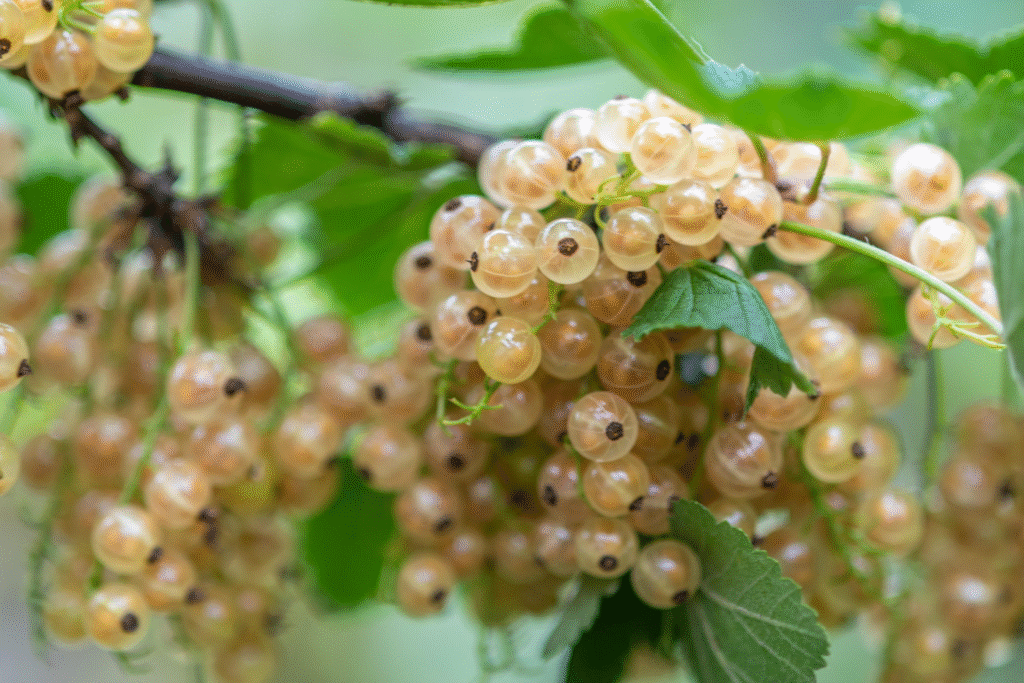
Pest and Disease Management
White currants can face several challenges, but proper preventative care minimizes issues:
Common Pests:
- Currant aphids: Control with strong water spray or insecticidal soap
- Currant fruit flies: Use floating row covers during egg-laying period
- Scale insects: Remove by hand or treat with horticultural oil
Common Diseases:
- Powdery mildew: Improve air circulation; apply organic fungicides if needed
- Leaf spot: Remove affected leaves; avoid overhead watering
- White pine blister rust: Check local regulations as some areas restrict Ribes cultivation
Integrated pest management practices such as proper spacing, strategic pruning, and encouraging beneficial insects help maintain plant health without excessive chemical use.
Harvesting and Using White Currants
When and How to Harvest
White currants typically ripen in early to mid-summer, depending on your climate:
- Timing: Harvest when berries are fully translucent white to pale yellow
- Harvesting technique: Pick entire fruit “strigs” (clusters) rather than individual berries
- Handling: Harvest in cool morning hours and refrigerate promptly
- Storage: Fresh currants will keep 3-5 days refrigerated
Unlike many fruits, white currants don’t continue ripening after picking, so harvest only when fully ripe for the sweetest flavor.
Culinary Uses for White Currants
White currants offer tremendous versatility in the kitchen:
Fresh Applications:
- Add to fruit salads for bright, tangy flavor
- Top pancakes, waffles, or yogurt
- Use as a striking garnish for desserts and cocktails
Preserved Applications:
- White currant preserves and jellies
- Currant syrup for beverages and dessert toppings
- Wine and cordials
- Fruit leather blends
Cooking Applications:
- Sauces for poultry and game
- Quick bread and muffin recipes
- Currant curd for tart fillings
The mild sweetness of white currants makes them particularly suitable for fresh eating compared to their more acidic red cousins.
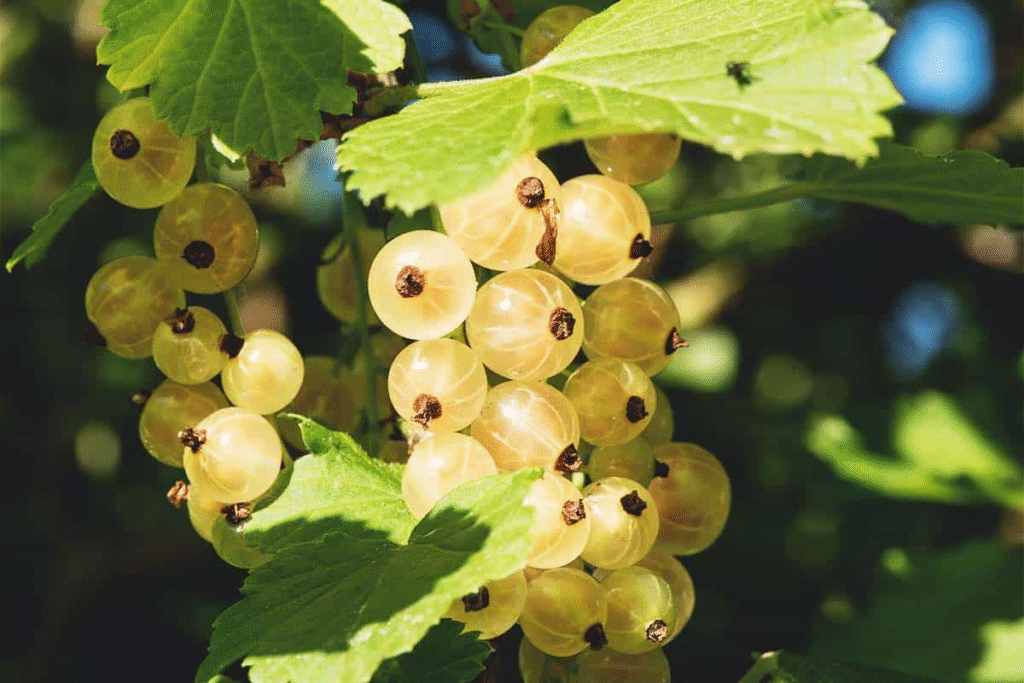
Troubleshooting Common Issues
Even experienced gardeners can encounter challenges when growing white currants. Here are solutions to common problems:
Poor Fruit Production:
- Insufficient chill hours: Select varieties suited to your climate
- Improper pruning: Maintain the right balance of 1, 2, and 3-year-old wood
- Inadequate pollination: Plant multiple currant varieties to improve pollination
Plant Health Issues:
- Yellowing leaves: Often indicates nitrogen deficiency or poor drainage
- Stunted growth: May signal root competition or nutrient deficiencies
- Winter damage: Provide wind protection and mulch in cold climates
Fruit Quality Problems:
- Small berries: Usually caused by drought stress or overcropping
- Split berries: Result of uneven watering during fruit development
- Early fruit drop: Often due to heat stress or insufficient pollination
Conclusion
Growing white currants offers numerous rewards for the home gardener. These adaptable shrubs provide beauty, nutritional benefits, and unique culinary opportunities. Whether you’re a seasoned gardener looking to expand your fruit collection or a beginner seeking a low-maintenance edible, white currants deserve consideration.
With proper site selection, regular care, and appropriate harvesting, you can enjoy bountiful harvests of these jewel-like berries for many years. The versatility of white currants—from garden to container, from fresh eating to preserves—makes them an excellent addition to any edible landscape.
Try incorporating white currants into your growing space this season, and discover the unique pleasures of cultivating these remarkable berries for yourself.
